Desert Rock VI
Observer programs were conducted at shots Wasp, Moth, Tesla, Turk, Bee, Ess, Apple 1, and Apple 2. Tactical maneuvers were conducted after shots Bee and Apple 2. Technical studies were conducted at shots Wasp, Moth, Tesla, Turk, Bee, Ess, Apple 1, Wasp Prime, Met, and Apple 2.
A test of an armored task force, RAZOR, was conducted at shot Apple 2 to demonstrate the capability of a reinforced tank battalion to seize an objective immediately after a nuclear detonation.
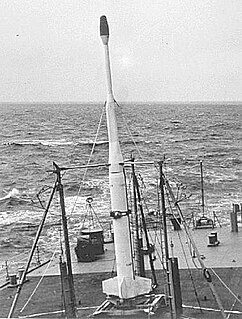
Operation Argus was a series of United States low-yield, high-altitude nuclear weapons tests and missile tests secretly conducted from 27 August to 9 September 1958 over the South Atlantic Ocean. The tests were performed by the Defense Nuclear Agency.

The Nevada National Security Site, known as the Nevada Test Site (NTS) until 2010, is a United States Department of Energy (DOE) reservation located in southeastern Nye County, Nevada, about 65 miles (105 km) northwest of the city of Las Vegas. Formerly known as the Nevada Proving Grounds, the site was established in 1951 for the testing of nuclear devices. It covers approximately 1,360 square miles (3,500 km2) of desert and mountainous terrain. Nuclear weapons testing at the site began with a 1-kiloton-of-TNT (4.2 TJ) bomb dropped on Frenchman Flat on January 27, 1951. Over the subsequent four decades, over 1,000 nuclear explosions were detonated at the site. Many of the iconic images of the nuclear era come from the site.

Operation Upshot–Knothole was a series of eleven nuclear test shots conducted in 1953 at the Nevada Test Site. It followed Operation Ivy and preceded Operation Castle.
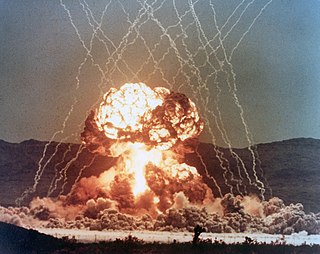
Operation Teapot was a series of 14 nuclear test explosions conducted at the Nevada Test Site in the first half of 1955. It was preceded by Operation Castle, and followed by Operation Wigwam. Wigwam was, administratively, a part of Teapot, but it is usually treated as a class of its own. The aims of the operation were to establish military tactics for ground forces on a nuclear battlefield and to improve the nuclear weapons used for strategic delivery.
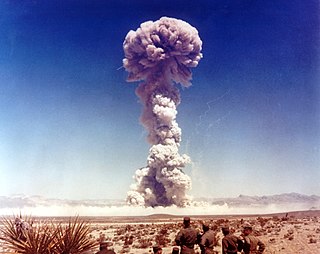
Operation Buster–Jangle was a series of seven nuclear weapons tests conducted by the United States in late 1951 at the Nevada Test Site. Buster–Jangle was the first joint test program between the DOD and Los Alamos National Laboratories. As part of Operation Buster, 6,500 troops were involved in the Operation Desert Rock I, II, and III exercises in conjunction with the tests. The last two tests, Operation Jangle, evaluated the cratering effects of low-yield nuclear devices. This series preceded Operation Tumbler–Snapper and followed Operation Greenhouse.
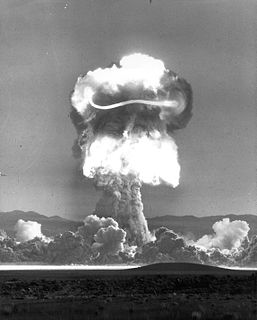
Operation Plumbbob was a series of nuclear tests that were conducted between May 28 and October 7, 1957, at the Nevada Test Site, following Project 57, and preceding Project 58/58A.
The Medium Extended Air Defense System (MEADS) is a ground-mobile air and missile defense system intended to replace the Patriot missile system through a NATO-managed development. The program is a development of the United States, Germany and Italy.
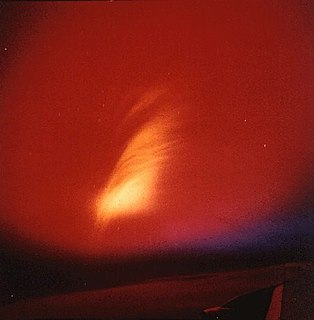
Starfish Prime was a high-altitude nuclear test conducted by the United States, a joint effort of the Atomic Energy Commission (AEC) and the Defense Atomic Support Agency. It was launched from Johnston Atoll on July 9, 1962, and was the largest nuclear test conducted in outer space, and one of five conducted by the US in space.

Operation Fishbowl was a series of high-altitude nuclear tests in 1962 that were carried out by the United States as a part of the larger Operation Dominic nuclear test program. Flight-test vehicles were designed and manufactured by Avco Corporation.

HARDTACK-Teak was an exoatmospheric high altitude nuclear weapon test performed during Operation Newsreel. It was launched from Johnston Atoll on a Redstone missile. On 1 August 1958, the 3.88 Mt (16.2 PJ) shot detonated at an altitude of 76.8 km.

The Totskoye nuclear exercise was a military exercise undertaken by the Soviet Army to explore defensive and offensive warfare during nuclear war. The exercise, under the code name "Snowball", involved an aerial detonation of a 40 kt RDS-4 nuclear bomb. The stated goal of the operation was military training for breaking through heavily fortified defensive lines of a military opponent using nuclear weapons. An army of 45,000 soldiers marched through the area around the hypocenter soon after the nuclear blast. The exercise was conducted on September 14, 1954, at 9.33 a.m., under the command of Marshal Georgy Zhukov to the north of Totskoye village in Orenburg Oblast, Russia, in the South Ural Military District. The epicenter of the detonation is marked with a memorial.

Operation Tumbler–Snapper was a series of nuclear weapons tests conducted by the United States in early 1952 at the Nevada Test Site. The Tumbler–Snapper series of tests followed Operation Buster–Jangle and preceded Operation Ivy.
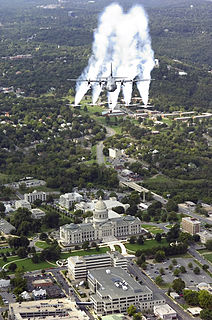
The 314th Airlift Wing is a wing of the United States Air Force based at Little Rock Air Force Base in Little Rock, Arkansas. Its mission is to carry out Lockheed C-130 Hercules combat airlift training.

The 439th Airlift Wing is an active United States Air Force Reserve unit. It is assigned to the Air Force Reserve Command, Fourth Air Force, and is based at Westover Air Reserve Base, Massachusetts.

The 547th Intelligence Squadron is an active United States Air Force (USAF) unit. It is assigned to the 365th Intelligence, Surveillance and Reconnaissance Group, stationed at Nellis Air Force Base, Nevada. The squadron serves as the USAFs center for adversary tactics analysis; develops intelligence threat training programs; defines potential threats to the US, provides intelligence support to Air Combat Command's test and evaluation programs and live-fly exercises.

Misty Picture was a test conducted on May 14, 1987 by the United States Defense Nuclear Agency involving the detonation of several thousand tons of conventional explosives to simulate the explosion of a small nuclear bomb.

The Deployable Operations Group (DOG) was a United States Coast Guard command that provided properly equipped, trained and organized Deployable Specialized Forces (DSF), which still exist today, to the Coast Guard, United States Department of Homeland Security (DHS), United States Department of Defense (DoD) and inter-agency operational and tactical commanders. Formerly headquartered in Arlington, Virginia, it was established on 20 July 2007, and was commanded by a captain and was decommissioned by the Commandant of the Coast Guard, Admiral Robert Papp on 1 October 2013, although many of the units existed long before the 2007 commissioning. Upon decommissioning, the units previously assigned to the DOG were split between Coast Guard Pacific and Atlantic Area commands.

Upshot–Knothole Encore was a nuclear weapons test conducted by the United States as part of Operation Upshot–Knothole. It took place on May 8, 1953 in Yucca Flat, in the Nevada Test Site.
Military exercises are conducted by the Pakistan Armed Forces to increase combat readiness, and to identify problems in logistics, training, and current military doctrine. They also test the ability of units to work together. Lastly, they act as a visible expression of military might, which acts as a deterrent to potential enemy action. An important component of each exercise is the after-action assessment. Since 1989 the four branches services have increasingly begun coordinated exercises.


















